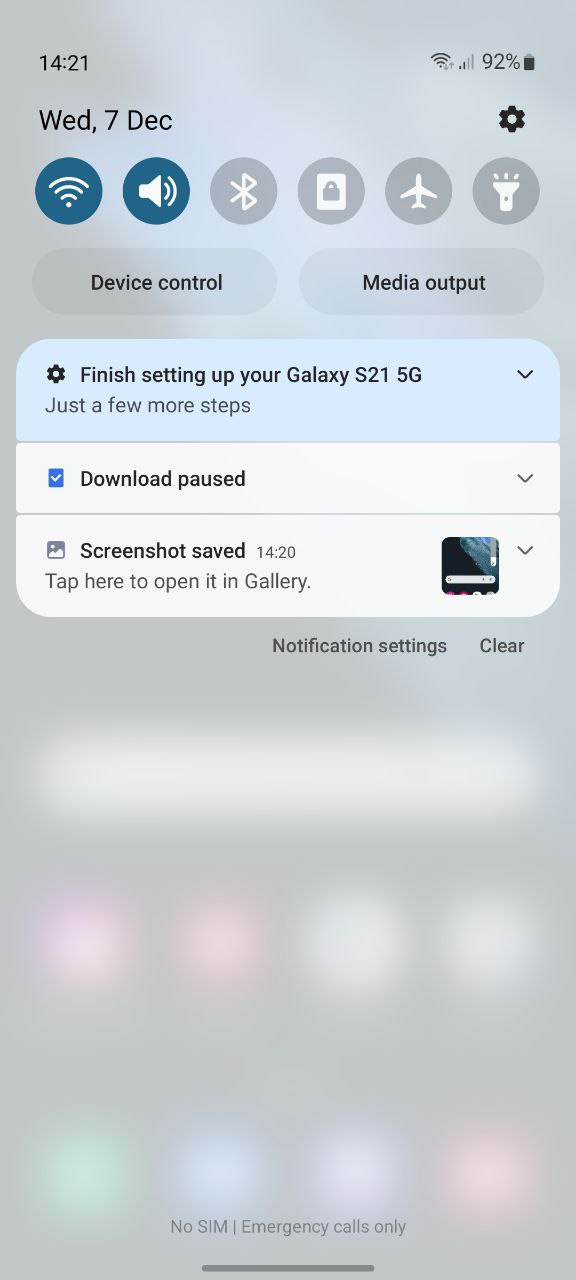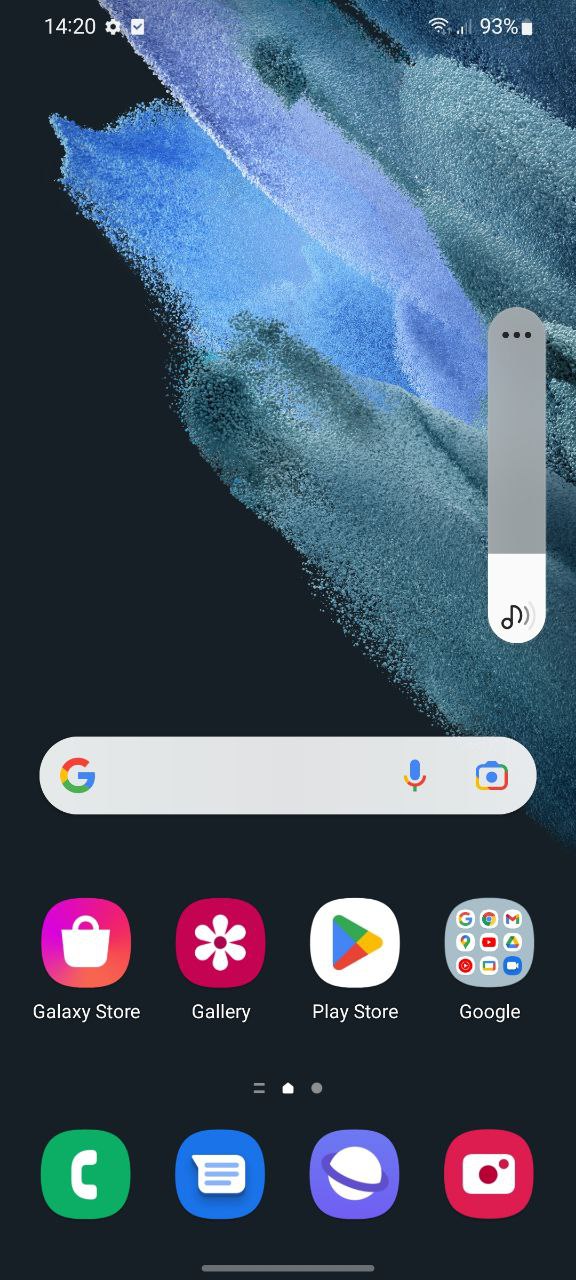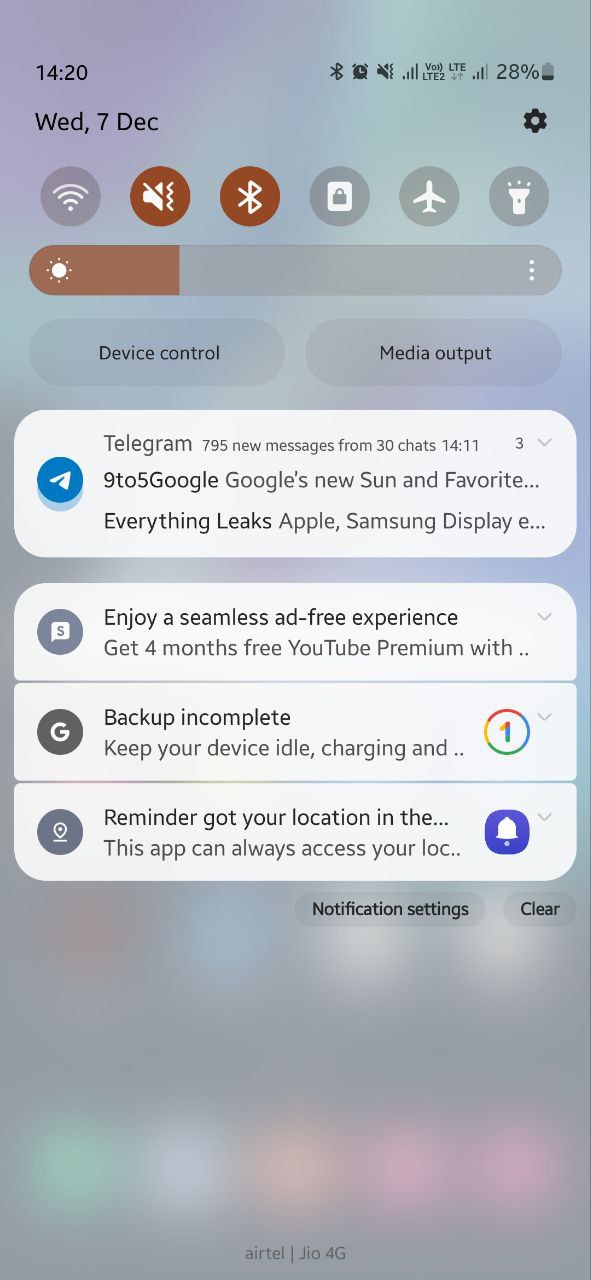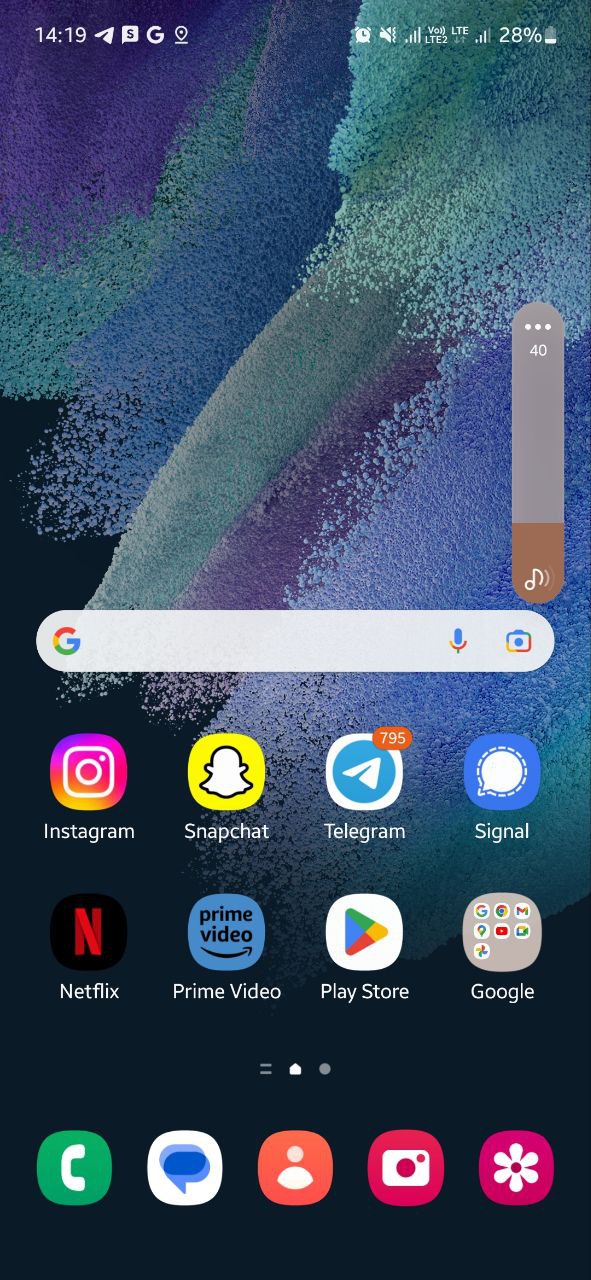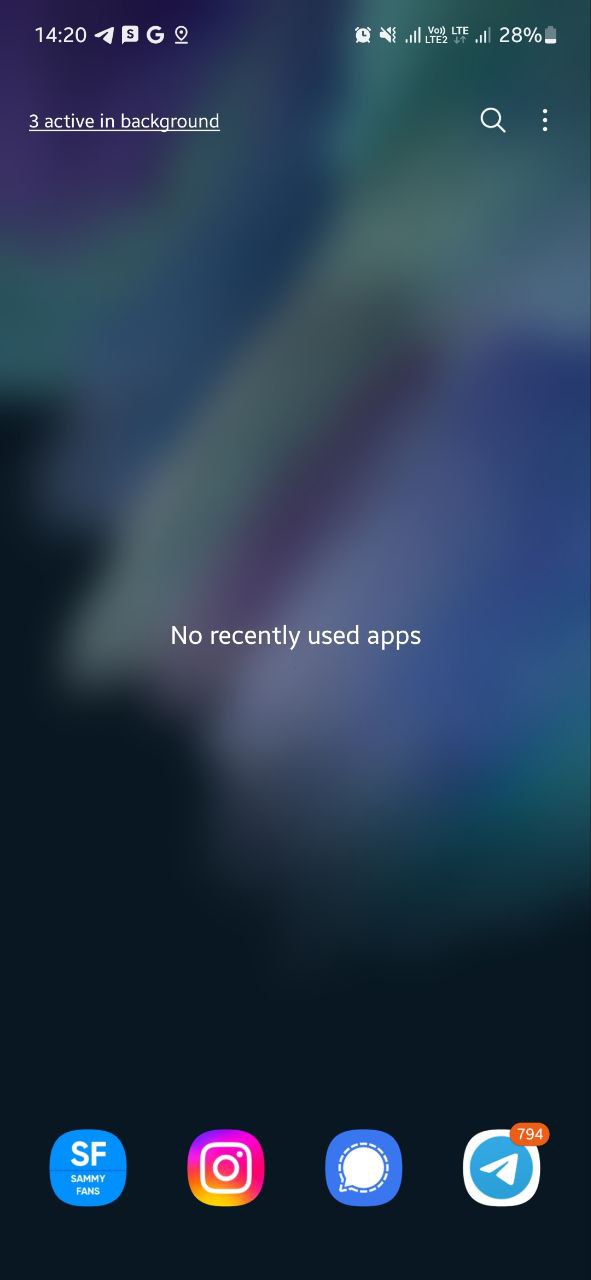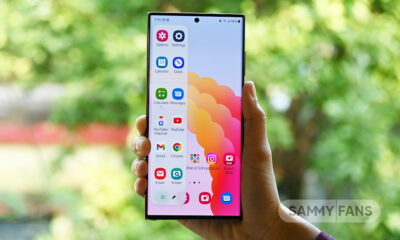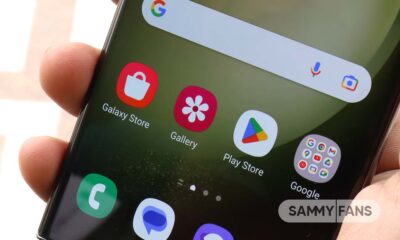Comparison
One UI 5.0 vs One UI 4.1 – What changes Samsung user interface gets
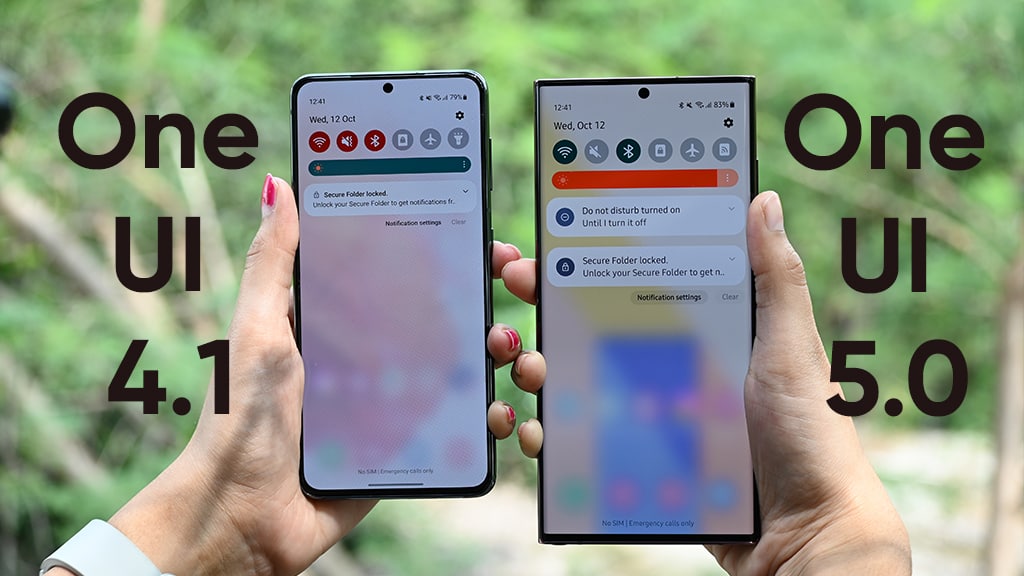
Samsung’s Android 13-based One UI 5.0 software is gracing millions of Galaxy devices with its all-new features and impressive user interface. Samsung has significantly improved its user interface with One UI 5.0 software and it’s quite appreciative.
One UI 5.0 sweetened animations, brings new app icons, and some notable changes to the quick settings panel, notification panel, home screen, etc. In this article, we will compare the user interface of Samsung’s previous One UI 4.1 software with the new One UI 5.0 software. Let’s check out what changes the company brings.
Join SammyFans on Telegram

One UI 4.1 User interface:
The design of Android 12-based One UI 4.1 is largely similar to Android 12-based One UI 4.0, which Samsung has developed from scratch to provide users with a more comfortable and personalized experience. However, this helps make system-wide navigation more intuitive.
One UI 4.1 Quick Settings Panel brought a larger brightness bar so it’s easier to see and adjust and the notification shade is less transparent. Whereas, the Notification panel introduced separation for silent and alert notifications to make it easier for you to triage information as it arrives.
On the other side, there were no notable changes in the rest of other elements of the user interface.
One UI 5.0 User interface:
One UI 5.0 brings further improvements to Samsung’s user interface. First of all, it has new and bolder app icons that give users a completely new look to their phones. The company has slightly reduced the transparency that improves the visibility of text elements and toggles. Whereas, the brightness slider adopts better dynamic colors from the wallpaper.
Furthermore, the Notification panel has subtle changes in the design. The company has tried to produce a clearer look, at the same time, keeping a separate space for different groups of apps or priority ones. It has received minor optimizations such as a new solid round background shape.
At the same time, if you receive more than one notification from a single application, you will see the icons stack below search other. It not only indicates that there are more notifications but also creates a pleasant effect. Aside from these, the “Notification settings” and “Clear” options placed at the end of the notification shade have also got their own rounded box.
Moving on to the Recent menu, it now has a new feature that will show you the apps running in the background so that you can easily determine what apps are consuming battery when you are not using your phone. Moreover, the Volume panel also gets a few improvements. It now better adopts Color Palette so that it can match your phone’s entire theme.
One UI 5.0 vs One UI 4.1 – Samsung user interface
Samsung One UI 4.1 user interface was good. But with One UI 5.0, the company has tried making it more clear and easy to use. The new notification panel that now has bigger app icons is praised, now you can now more easily choose which notification is useful and which is not.
At the same, the app icons, which are getting some gradient effects, look good and also end that boring sense of the One UI 4.1 interface. The Recent menu is also nice, you can now clearly detect which apps are drawing battery on your phone through the “active in background” function.
Overall, I can say that Samsung has greatly worked to bring us a clearer and more effective user interface on One UI 5.0/Android 13. The new interface’s look and feel remain modern and sleek.
Comparison
Galaxy Z Fold SE Camera: Samsung’s Z Fold 6 buyers could regret

Samsung’s Galaxy Z Fold 6 buyers could regret knowing the Z Fold SE (Special Edition) camera specs. Amid intense competition, Samsung has made a pretty solid entry in the foldable landscape with the launch of Special Edition.
The Galaxy Z Fold SE is not only slim but packs a 200-megapixel main camera. It’s a significant upgrade over the Galaxy Z Fold 6’s outdated 50-megapixel sensor. The upgraded camera on Samsung foldables is a long-due demand of consumers.
The Z Fold Special Edition has become the third Samsung phone to pack a 200MP camera. The company first debuted its monstrous 200-megapixel sensor with the Galaxy S23 Ultra, while used in the Galaxy S24 Ultra as well.
The sensor offers 2x optical quality zoom apart from higher resolution benefits. The Korean tech giant highlights that the Galaxy Z Fold SE’s 200-megapixel wide-angle lens “supports more vivid and clear photos and videos.”
The 12-megapixel ultrawide, 10-megapixel 3x telephoto and 10-megapixel cover selfie camera remain the same in both folds. The 4MP under-display camera is ditched from the Z Fold SE, probably, as part of improving the crease control.
Thanks to the cover screen, the Galaxy Z Fold SE’s 200MP camera could be used to take selfies. The inner screen camera is not much used by users. Still, the 4MP resolution without UDC tech would deliver better results than the Z Fold 6.
Earlier, we’ve covered Samsung should’ve teased the Special Edition model during the launch of the Galaxy Z Fold 6. Despite limited availability, the Z Fold 6 buyers would regret their decision to own the foldable released in late July.
| Feature | Galaxy Z Fold SE | Galaxy Z Fold 6 |
|---|---|---|
| Main Camera | 200-megapixel | 50-megapixel |
| Ultra-Wide Camera | 12-megapixel | 12-megapixel |
| Telephoto Camera | 10-megapixel | 3x Optical | 10-megapixel | 3x Optical |
| Front Camera (Cover Screen) | 10-megapixel | 10-megapixel |
| Front Camera (Inner Display) | 4-megapixel | punch-hole | 4-megapixel | UDC |
// Difference is bolded.
Comparison
Samsung Galaxy A55 5G vs Google Pixel 7a – Battle of affordables
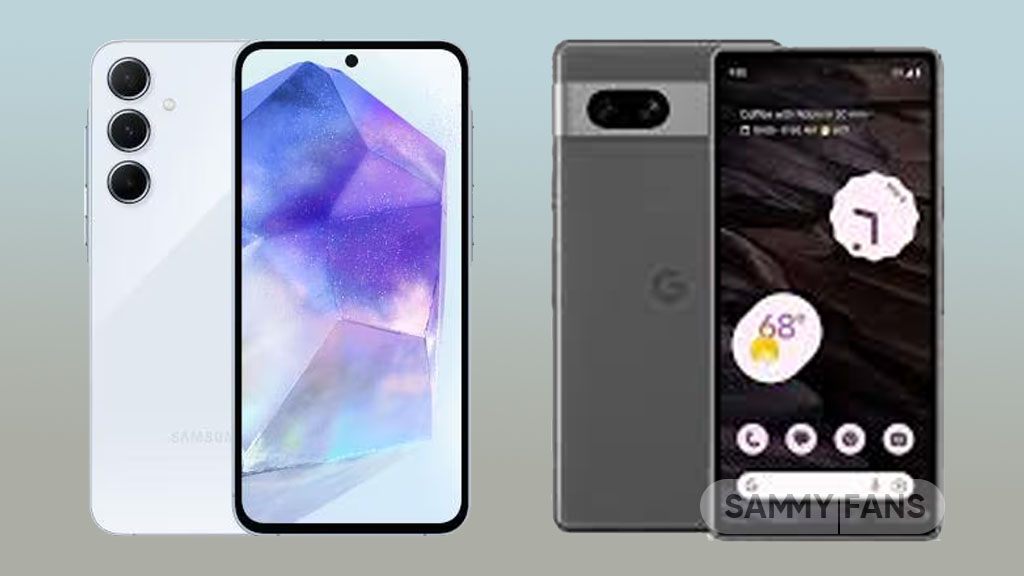
The smartphone market is growing constantly, and Samsung has recently released a new A series phone the Galaxy A55 5G, that can ultimately compete with the one launched back in 2023 by Google, yes, here we are talking about the Pixel 7a.
Samsung Galaxy A55 5G and Google Pixel 7a are two of the latest additions to the affordable segment. Both devices offer impressive features at a budget-friendly price point. So, just get ready to dive into the battle of the latest affordable smartphones.
In this article, we’ll compare these two smartphones and see how they stack up against each other in terms of design, performance, camera capabilities, battery life, and more.
Follow our socials → Google News | Telegram | X/Twitter | Facebook | WhatsApp
Samsung Galaxy A55 5G vs Google Pixel 7a
Display and Design
The Galaxy A55 5G looks sleek and stylish with its slim profile and glass back. On the other side, the Pixel 7a boasts a striking design with its matte finish and horizontal camera module. In terms of display, the Galaxy A55 5G features a Super AMOLED panel, while the Pixel 7a offers an OLED display.
Both devices provide immersive viewing experiences, the newly launched one offers a larger 6.6-inch display with 120Hz refresh rate. While the other one features a 6.1-inch screen with a 90Hz refresh rate.
Processor
Under the hood, the Galaxy A55 5G equips a powerful Exynos 1480 octa-core processor, with 8GB, 12GB RAM, and 128GB, and 256GB storage options ensuring smooth multitasking and lag-free performance. Whereas, the Pixel 7a is powered by a Google Tensor G2 chip paired with 8GB RAM and 128GB storage configuration.
Battery and Connectivity
In terms of battery, the newly launched Galaxy A55 5G is a real winner with support of a 5000mAh battery and 25W charging. As the Pixel 7a only offers a 4385mAh battery with 18W wired and 7.5W wireless charging support. Simultaneously, both devices support 5G connectivity and Bluetooth 5.3.
Camera
Now comes the photography section, for which the world is crazy, Samsung Galaxy A55 5G boasts a versatile triple camera setup consisting of a 50MP Main, 12MP Ultra-wide, and 5MP Macro lens. Whereas, Google’s Pixel 7a sport dual camera setup including a 64MP and 13MP Ultra-wide angle lens.
Software
In terms of software, the Galaxy A55 5G comes pre-installed on the latest Android 14-based One UI 6.1, but it lacks Galaxy AI capabilities. While the Pixel 7a arrived out of the box with Android 13, but it currently offers a pure and premium experience with the latest version of Android.
Color Options
Both devices offer a choice of four color options so that customers can select the one that suits their preference most. Like the Galaxy A55 is available in Iceblue, Lilac, Navy, and Lemon, while, the Pixel 7a is offered with Charcoal, Snow, Sea, and Coral colorways.

Comparison
Galaxy A35 Vs Nothing Phone 2a: Samsung leads 2024 mid-range segment
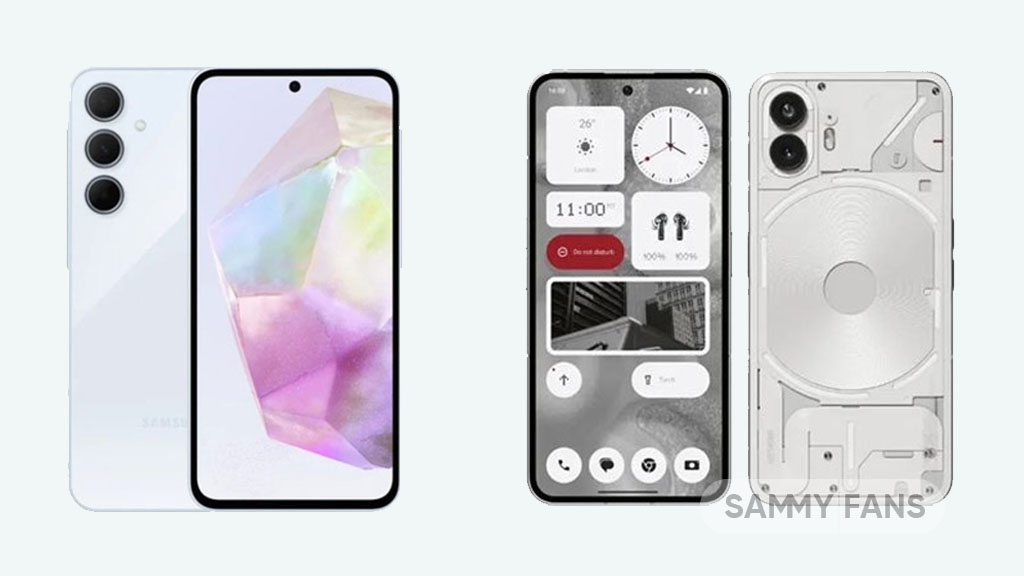
Looking to buy a new budget-friendly smartphone packed with ultimate features, functions, and capabilities, but getting confused between newly released devices – Samsung Galaxy A35 5G and Nothing Phone 2a?
If yes, then don’t think twice as Samsung leads the 2024 mid-range segment and you are at the right place because here we will discuss the design, display, performance, camera capabilities, and more aspects of both these devices, to help you decide which one is the perfect fit for you and deserves to be in your pocket this year.
Samsung Galaxy A35 vs Nothing Phone 2a
Design
Starting with the design, those who love a slim profile with premium build quality can go with Galaxy A55 5G while those who prefer to go with a minimalist approach and unique look can opt for Nothing Phone 2a. Both phones have remarkable appearance, so the choice depends on your personal preference.
Display
The Galaxy A35 5G offers a 6.6-inch Super AMOLED display with 1080 x 2340 pixels. While the Nothing Phone 2a features a bigger 6.7-inch AMOLED screen with 1084 x 2412 pixels. Overall, both device has the ultimate visual experience and smoother scrolling with a 120Hz refresh rate.
Performance
In terms of performance, the Galaxy A35 5G is powered by an Exynos 1380 processor to offer smooth multitasking and ultimate gaming, and seamless performance. On the other side, the Nothing Phone 2a features a MediaTek Dimensity 7200 Pro chip to perform your everyday tasks.
Camera
Talking about the camera capabilities, so the Galaxy A35 5G packs a triple-camera setup at the back including 50MP Wide Angle, 8MP Ultra Wide, and 5MP Macro lens to capture detailed and vibrant photos. While Nothing Phone 2a offers a 50MP dual camera, with 13MP and 32MP cameras on the front.
Battery and Software
The Galaxy A35 and Nothing Phone 2a both pack 5000mAh battery but one offers 25W fast charging, while the other provides the ultimate 45W charging support. In terms of software, the Galaxy A35 runs on Android 14-based One UI 6.1 custom skin, and, Nothing Phone 2a is powered on Nothing OS 2.5 software based on Android 14 OS.
Other details
Other details of both the phones are similar in some aspects like both are available in 8GB RAM with 128GB storage configurations, launched in March, support 5G connectivity, in display fingerprint scanner, and much more.
Follow our socials → Google News | Telegram | X/Twitter | Facebook | WhatsApp
In conclusion, both devices have their strengths and weaknesses, but as Samsung is known to deliver a more optimized experience to its users and elevated software update support as compared to Nothing Phone 2a, so we recommend users to go with the Galaxy A35 5G and the rest of the choice is all yours.



